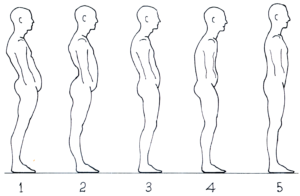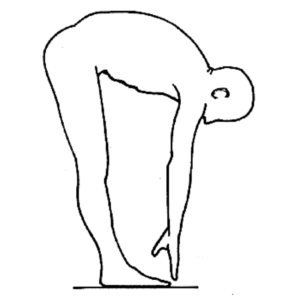This article was first published in "Going Mental" by Daniel McGowan
Various Examples of Misuse in Standing

The picture of the general action of the muscles to keep us standing is now complete. This act of standing is not something static and fixed, but a dynamic system of constant adjustment by the muscles and other connective tissue to the tendency of the free-standing form to fall down under the influence of gravity. The act of standing quietly on both feet with grace, poise and dynamism, allowing yourself the freedom to fall, is as much an art as any movement we make. Fluent standing, fluent “posture” so to say, forms the basis of free-flowing, graceful movement.
Gravity is not, however, the negative force that we habitually regard it to be. It does not pull you down, it takes you up; stretches you up at the neck and down at the lower legs. It also facilitates the torso as a suspension system. There are, obviously, many more muscles other than those mentioned in the foregoing pages, that contribute to this suspension system and to the act of standing.
If your use of the self’s form was co-ordinated and balanced, then you would look something like the man in the 5th in the picture above. His spine is at its optimal length, and his head is not pulled back, which means that his vocal apparatus, thyroid gland, oesophagus (food-pipe), stomach, trachea (wind-pipe), shoulder girdle and rib-cage are suspended from his head and the cervical spine in his neck.
The other fellows are displaying variations of misuse, where the back is shortened and the muscles are pulled down excessively. This is a fight for survival, where the muscles are forced into all kinds of stressful shortening and flaccidity to keep the so-called body upright.
The spine shortens because, through misuse of the organism, the intervertebral discs become flatter, sometimes to the point where the disc becomes non-existent and the vertebrae fuse together. Fluid at the centre (nucleus pulposis) of the discs, which is vital to the buoyancy of the spine, is also forced out.
Note that the men in pictures 1, 2, 3, 4 are all shorter in stature than number 5.
Another point worth noting is, that if there is a pronounced forward curving of the lumbar spine (lordosis) as in figure No. 2, and if this man can bend down and touch his toes like the man in the photo below, then, despite the fact that in the standing situation his spine appears shortened, his lumbar spine is actually too long and, therefore, too flaccid. In standing, it collapses down on itself and becomes distorted. This distortion can lead to chronic problems.

This article was first published in Going Mental by Daniel McGowan. You can download the PDF of this book for free here: FREE DOWNLOAD